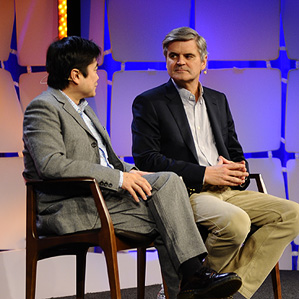AOL Cofounder Frets That the U.S. Could Lose Its Entrepreneurial Edge
Entrepreneurs made America the leader of the free world, and only entrepreneurs can keep it there.

That’s according to Steve Case, the billionaire founder of America Online, who is reëmerging as an influential figure in Washington, D.C., and one of the country’s most important technology investors.
Case cofounded AOL, a company that, with its CD-ROMs and memorable TV ads, helped connect America to the Internet back in the 1990s. Worth as much as $172 billion near its peak, the company lost its prominence on the Web after an ill-fated 2000 merger with old-media conglomerate Time Warner.
But Case has come back into public view with a strongly pro-American take on the role of entrepreneurs in the economy.
In addition to his lobbying activity and venture fund, called Revolution, Case, now 55, also runs a charitable foundation with his wife. “These activities are all under the same umbrella of doing what I can to make sure the U.S. stays the most innovative, entrepreneurial country in the world,” Case said during MIT Technology Review’s EmTech conference.
In September, Revolution raised a new fund of $200 million that Case says will invest 90 percent of its money outside of Silicon Valley, in places like North Carolina and Austin, Texas. His team calls the strategy “the rise of the rest.”
“We’re looking for entrepreneurs off the beaten track. Everyone is aware of Silicon Valley, Boston, and New York, but there are a lot of awesome entrepreneurs elsewhere, and we are trying to find them and back them,” says Case.
Technology companies are getting easier to start anywhere, and if funding were to follow, then innovation could be more widely dispersed around the country, Case thinks. Globally, just four U.S. urban areas and the United Kingdom account for half of all venture capital investments (see “In Innovation Quest, Regions Seek Critical Mass”)
Revolution, based in Washington, D.C., thinks it may pick up better deals—at lower prices—by paying attention to areas that investors in California “have left on the table.” Case thinks the Internet is going to start to transform health care, education, and transportation. Those are huge, regulated industries where the government is the largest customer. Case, who has lived in the Washington area for 30 years, thinks he might have an advantage compared to Silicon Valley’s go-it-alone, anti-government attitude.
Until two years ago, Case was quietly investing his personal fortune, which Forbes put at $1.2 billion. But in 2011, Revolution began raising outside money with the idea of becoming the biggest venture capital fund in the eastern half of the U.S. It has raised $650 million so far, investing most frequently in e-commerce companies.
At the same time, Case was appointed to President Obama’s Council on Jobs and Competitiveness, a group of business advisers. Case says he used his access to the president to push for the JOBS Act, legislation that updates parts of U.S. securities legislation to be more favorable to startups and early-stage investors.
One key provision of the JOBS Act permits startups to openly advertise and solicit investments from the public, including on investing websites (see “Crowd Investing Is the New Way to Finance Technology Development”). That could let entrepreneurs in more parts of the country raise money easily.
The AOL founder says his other priority in Washington is the passage of an immigration reform bill. Investors complain that the U.S. trains foreign students but makes it difficult for them to stay in the country. Instead, they leave to start companies elsewhere (see “Silicon Valley Fights for Immigrant Talent”).
“The central issue around entrepreneurship is making sure that we win the global battle for talent,” says Case. “Other nations have figured out that entrepreneurialism and innovation are the secret sauce.”
In lobbying both Democrats and Republicans on Capitol Hill to ease immigration rules, Case says he tries to lay out the problem in stark terms. He asks them if it would make sense to bring people from China to the U.S. Naval Academy, teach them everything about naval warfare, and then send them home to build the Chinese navy. “They say, ‘Oh, no, we wouldn’t do that.’ “
What really worries Case is how fast economic success can disappear. He recently visited Detroit, where an explosion of automobile companies in the 1950s made the city into the world’s center of entrepreneurial activity and innovation. Since then, however, Detroit has lost more than half its population. In July, the city declared bankruptcy. “What happened there is pretty scary,” Case says. “Detroit lost its entrepreneurial mojo.”
Case says his aim is to make sure that doesn’t happen to the U.S. as a whole. “Other countries are working hard to shift the center of gravity away from us, so we can’t get complacent,” he says.
Keep Reading
Most Popular
Large language models can do jaw-dropping things. But nobody knows exactly why.
And that's a problem. Figuring it out is one of the biggest scientific puzzles of our time and a crucial step towards controlling more powerful future models.
The problem with plug-in hybrids? Their drivers.
Plug-in hybrids are often sold as a transition to EVs, but new data from Europe shows we’re still underestimating the emissions they produce.
How scientists traced a mysterious covid case back to six toilets
When wastewater surveillance turns into a hunt for a single infected individual, the ethics get tricky.
Google DeepMind’s new generative model makes Super Mario–like games from scratch
Genie learns how to control games by watching hours and hours of video. It could help train next-gen robots too.
Stay connected
Get the latest updates from
MIT Technology Review
Discover special offers, top stories, upcoming events, and more.